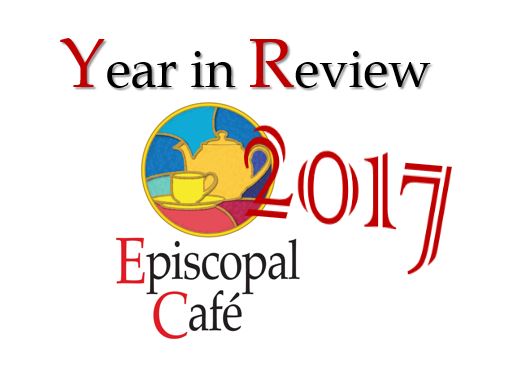Our Magazine section, with selections each weekend, is the place where we share the stories of life in the church. Below are our top ten stories from 2017. Click the headline to read the whole selection:
Rethinking the transition process
by George Clifford
 George offers some ideas for improving the transition process to ensure good matches between clergy and congregations with less pain for all
George offers some ideas for improving the transition process to ensure good matches between clergy and congregations with less pain for all
The search processes for diocesan bishops, rectors, and vicars are broken. Little evidence exists, beyond anecdotes, to demonstrate that the current processes efficaciously select clerics who succeed in their new posts, regardless of one’s definition of success. Indeed, numerous anecdotes suggest that the processes result in calling unsuccessful leaders at least as often as the processes result in calling successful leaders. Furthermore, the current processes entail excessive and unnecessary delays and costs.
Significant improvements are easily identified and implemented.
My dear Episcopal Church
by Maryann Younger
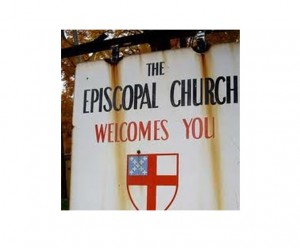 In this post we were reminded that it’s not enough to go to church, but that we are called to be the church, the body of Christ in our neighborhoods and daily life
In this post we were reminded that it’s not enough to go to church, but that we are called to be the church, the body of Christ in our neighborhoods and daily life
I’ve also heard and read enough conservative thinkers – and there are many loud voices in this camp – to know that the evangelical church thinks we’ve lost our way. One even asking, ‘What does liberal Christianity even stand for but for legitimizing homosexual desire and approbation for sexual permissiveness?’
Um, wow.
Here’s what we stand for: we stand for the dignity of every person. We stand for loving each other, and especially those who aren’t like us. We stand for a loving inclusive God who is all about standing with the oppressed and the marginalized. It’s that whole Matthew 22:37-40 statement about loving God and loving each other.
But here’s the thing – we need to do more than stand for something. We need to move with it, too. It is not enough to wait for folks to walk through our door and to make sure they have a good experience when they arrive. (Make no mistake, that initial experience is really important, but let’s save that discussion for another day.)
Going to church alone
by Egan Millard
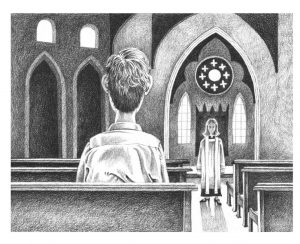 New to Portland Maine, Egan Millard showed up for an evening service one night at an unfamiliar church, what he discovered inside was that he was the only one, other than the priest, who had shown up for the 5:15 service. He recounted his experience for the Portland Press Herald, where he worked.
New to Portland Maine, Egan Millard showed up for an evening service one night at an unfamiliar church, what he discovered inside was that he was the only one, other than the priest, who had shown up for the 5:15 service. He recounted his experience for the Portland Press Herald, where he worked.
“I took a seat and looked up into the chapel’s spire. Every once in a while, some muffled fragment of a sound would surface briefly – a faint siren, rain on the roof – before dissolving. Candlelight brought a warm glow to the chapel’s wood-paneled walls, which fold into a partial dome over the altar. If you haven’t been to an evening event there, just imagine being cradled in a conch shell under a dark sea.
Though Egan was a little uncomfortable and unsure, the celebrant, the Rev Anne Fowler wasn’t.
“I’ll start with these prayers, as usual,” she said, opening the program. “Would you like to do the readings?”
I told her I would, and we began. The service started just like any other, except that Anne’s voice was quieter than it would have been otherwise. Many of the prayers are fixed in the liturgy, so the words don’t change from week to week, but they sounded different this time. They weren’t just being recited into the ether. They were being spoken to me. They were being offered for me.
The power of naming
By Ann Fontaine
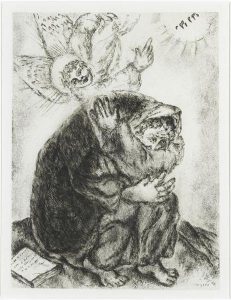 Longtime Cafe contributor, Ann Fontaine reflected on the debate over whether or not the president should be prayed for or not
Longtime Cafe contributor, Ann Fontaine reflected on the debate over whether or not the president should be prayed for or not
My spiritual director modeled praying for her abuser – and I saw that it changed her. Her prayers did not change the other person and did not say what happened was in any way anything but evil. I decided to try it and I found a different sort of peace. Do I still have anger about what happened? Yes, but I am not holding the poison of that anger and bitterness inside. I wrestled with saying Donald in the prayers of the people when it was my turn to pray (I am not priest in charge) – could I do it without being sick? I do it because it is my practice and it is a decision that our church made after the election.
Also there are people in our congregation who choked on praying for “Barack” by name and who voted for the president-elect. They would find it more than odd if we stopped our practice of naming now. They already feel in the minority in the Episcopal Church but soldier on in the community.
I wonder about the idea of church as safe space and think that sets us up for failure. I have not found it to be safe all the time. Many Bible passages are terrifying: Lot offering his daughters to the crowd to be raped. Eli’s sons use their position to take advantage of women. Jephthah’s daughter is sacrificed because of a rash promise. The crucifixion.
Signs of hope in 2016 TEC stats
by Jon White
 Parsing the latest churchwide stats to see that there isn’t a single narrative (including decline) encompassing the experience of parishes and dioceses across the church
Parsing the latest churchwide stats to see that there isn’t a single narrative (including decline) encompassing the experience of parishes and dioceses across the church
Though the church has seen these kinds of declines for more than a decade, the rate of decline has slowed. This is part of a broader change across American culture that has seen religious affiliation and participation decline across almost all Christian bodies.
Diocesan level statistics though don’t tell the whole story. Even in dioceses that have seen overall decline, there are individual parishes that are growing (and in growing dioceses, there are parishes in decline). For example, we looked closely at two dioceses, Vermont and West Tennessee. Vermont stood out in Province 1 with 2.2% growth in ASA. Looking at each parish in that diocese we see that a majority (19) have seen some increase, while 14 remain essentially unchanged and 13 showed lowered attendance. So in this diocese, the growth of the majority more than made up for the losses in only a third of the parishes across the diocese.
Looking at West Tennessee, as we might expect, we see the opposite. Here slightly more than half of the parishes reporting reported reduced ASA. But even here, 25% of the parishes showed growth.
An open letter to the Church of England
by Dan Ennis
 After the ACNA appointed a missionary bishop to the UK, with GAFCON’s backing, Dan Ennis offered some advice to fellow Anglicans in England
After the ACNA appointed a missionary bishop to the UK, with GAFCON’s backing, Dan Ennis offered some advice to fellow Anglicans in England
Missionary bishops are touchy about invitations and membership
Lots of faith organizations employ the title of bishop. Methodists have bishops. Mormons have bishops. UFO worshippers have bishops. GAFCON bishops, however, want the world to know they are official, on-the-level, capital-A Anglican bishops. They are repelled by inclusiveness of the Anglican Communion, but they crave inclusion. For example, getting invited to a meeting with the Archbishop of Canterbury is a big deal for a breakaway GAFCON bishop. Imagine how disappointing it must be when that the same Archbishop of Canterbury declares that your particular breakaway group is not part of the Anglican Communion. You Britons should expect the new missionary bishop not only to loudly lobby for invitations to Lambeth, but also to ostentatiously fling any such invitations into the Thames. This thirst for recognition leads fantasies of church polity, in which breakaway Anglican bishops insist they are authentically Anglican, the evidence being that they sometimes appear in photos beside bona fide Anglican bishops. One is reminded of the great theologian Groucho Marx, who declared that he would not want to be a member of a club that would admit him. In the case of your missionary bishop, expect him to simultaneously insist he’s a card-carry member of the Anglican Communion, but also to cast doubt on the integrity of any communion that includes the currently apostate Church of England.
The loss of common prayer
by Irene Lawrence
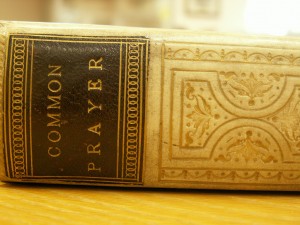 Again responding to BCP revision, asked what we meant by “common” prayer and whether any revisions might recapture its sense if not exactly the form of its past meaning
Again responding to BCP revision, asked what we meant by “common” prayer and whether any revisions might recapture its sense if not exactly the form of its past meaning
But more important than the loss of the “Book” is the loss of “common” prayer in the old uniform sense. While there is little today that is theoretically inaccessible to a determined lay person, in actual practice the number and unpredictability of the resources available excludes most lay people from ownership of the liturgy. Thus the appropriate liturgical leadership of the clergy has effectively become an exclusive leadership. It is true that usually today the laity have more lines and bigger parts than in the 1928 BCP. But there is a new randomness to the liturgy; it is no longer the work of the people, but is more of a performance staged by the clergy in which the people are given, often generously, things to do and say. Ironically, this is completely antithetical to the intentions of the 1979 BCP baptismal theology/ecclesiology.
My crystal ball is no clearer than anyone else’s, but I don’t think a one-prayer-book church is likely to be recovered. That bird has flown, that ship has sailed, and that toothpaste can’t be squeezed back into the tube. If the old understanding of “common” prayer is dependent on uniformity and a one-prayer-book church, and if that is no longer possible or desirable in a church that rejects privilege and is attempting to be inclusive and inculturated, what does “common” prayer mean now?
Behind the rail
by Ann Moul
 This loving and beautiful post reminded us of the power of the sacraments while sharing the spiritually imbued experience of those who serve “behind the rail.”
This loving and beautiful post reminded us of the power of the sacraments while sharing the spiritually imbued experience of those who serve “behind the rail.”
The rail itself is the great leveler. We are all the same at this table, cushioned on the beautifully embroidered kneelers, we cling to the Good News that the body and blood of Christ will save us from whatever awaits at the end. We feed everyone; the faithful weekly regulars, the Christmas- and Easter-only attendees, the homeless man who smells bad, (and around whom people jostle to avoid sipping from the cup after him) the young man with disturbing piercings and an unnaturally red beard, the elderly parish matriarch gripping her walker in a haze of dementia, guided by her husband, now gaunt and ravaged by cancer himself. Their adult daughter walks behind them. “I’m the spotter,” she whispers with a sad smile. No one is turned away even though as our rector once said, “I know there are people at the rail who would just as soon stab me in the back as talk to me, but none of it matters in that moment.”
For Such a time as this: an electronic prayer book &
Further thoughts on an all-digital BCP
by George Clifford
In this pair of posts, George Clifford said why he thought a digital format BCP was the best and responded to some critiques of his proposal
Printing a revised Book of Common Prayer is inadvisable:
- Many small congregations already struggle financially. Their having to replace the 1979 Book of Common Prayer with a revised book will only compound pre-existing financial problems.
- Determining the contents of a new prayer book might prove impossible or even a catalyst for schism as individuals and groups fight over what to include in a volume that by its various nature is both limited (e.g., a 2000 page book would be unmanageable) and static.
- The pace of social change is accelerating. Creating another static volume would probably result in a volume that was dated and in need of revision before it was fully implemented across the denomination.
- One unmistakable direction of change is away from print toward electronic media. Some congregations have already effected this change. Instead of (or in addition to) a printed bulletin, they publish their bulletin electronically for access by people using smartphones and tablets.
- Juggling the prayer book, one or more of our authorized hymnals, a bulletin, and perhaps a bulletin insert with the scripture readings, can leave a visitor to our worship services feeling bewildered and out of place. Consequently, numerous congregations now print their entire liturgy in the bulletin. This tactic welcomes visitors – a critical tactic for a denomination both suffering from numerical decline and one in which a majority of our current growth comes from adults moving to the Episcopal Church from another denomination.
Moving from a printed Book of Common Prayer to only an electronic version clearly represents the best alternative to a printed prayer book:
Many thanks to our contributors and readers in 2017. Have a story to share? Please consider submitting it to us and maybe yours will be on our top ten list of 2018!

